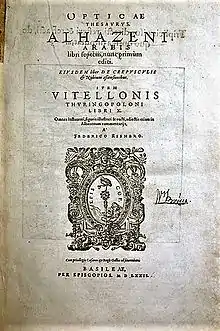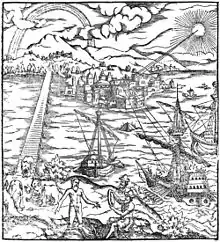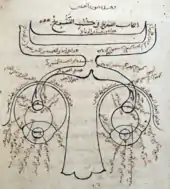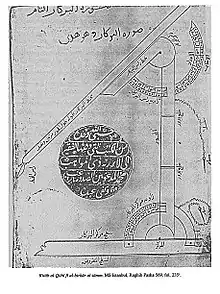Book of Optics
The Book of Optics (Arabic: كتاب المناظر, romanized: Kitāb al-Manāẓir; Latin: De Aspectibus or Perspectiva; Italian: Deli Aspecti) is a seven-volume treatise on optics and other fields of study composed by the medieval Arab scholar Ibn al-Haytham, known in the West as Alhazen or Alhacen (965–c. 1040 AD).
 Cover page for Ibn al-Haytham's Book of Optics in the print edition from 1572[1] | |
| Author | Ibn al-Haytham |
|---|---|
| Original title | كتاب المناظر |
| Language | Arabic |
| Published | 1011 to 1021 |

The Book of Optics presented experimentally founded arguments against the widely held extramission theory of vision (as held by Euclid in his Optica), and proposed the modern intromission theory, the now accepted model that vision takes place by light entering the eye.[2]: 60–7. [3][4][lower-alpha 1][lower-alpha 2] The book is also noted for its early use of the scientific method, its description of the camera obscura, and its formulation of Alhazen's problem. The book extensively affected the development of optics, physics and mathematics in Europe between the 13th and 17th centuries.[5]
Vision theory
Before the Book of Optics was written, two theories of vision existed. The extramission or emission theory was forwarded by the mathematicians Euclid[6] and Ptolemy,[7] who asserted that certain forms of radiation are emitted from the eyes onto the object which is being seen. When these rays reached the object they allowed the viewer to perceive its color, shape and size. An early version of the intromission theory, held by the followers of Aristotle and Galen, argued that sight was caused by agents, which were transmitted to the eyes from either the object or from its surroundings.
Al-Haytham offered many reasons against the extramission theory, pointing to the fact that eyes can be damaged by looking directly at bright lights, such as the sun.[8]: 313–314 He wrote that the low probability that the eye can fill the entirety of space as soon as the eyelids are opened as an observer looks up into the night sky.[9][10] Using the intromission theory as a foundation, he formed his own theory that an object emits rays of light from every point on its surface which then travel in all directions, thereby allowing some light into a viewer's eyes. According to this theory, the object being viewed is considered to be a compilation of an infinite number of points, from which rays of light are projected.[11][12]
Light and color theory
In the Book of Optics, al-Haytham hypothesized the existence of primary and secondary light, with primary light being the stronger or more intense of the two. The book describes how the essential form of light comes from self-luminous bodies and that accidental light comes from objects that obtain and emit light from those self-luminous bodies. According to Ibn al-Haytham, primary light comes from self-luminous bodies and secondary light is the light that comes from accidental objects.[8]: 317 [13] Accidental light can only exist if there is a source of primary light. Both primary and secondary light travel in straight lines. Transparency is a characteristic of a body that can transmit light through them, such as air and water, although no body can completely transmit light or be entirely transparent. Opaque objects are those through which light cannot pass through directly, although there are degrees of opaqueness which determine how much light can actually pass through. Opaque objects are struck with light and can become luminous bodies themselves which radiate secondary light. Light can be refracted by going through partially transparent objects and can also be reflected by striking smooth objects such as mirrors, traveling in straight lines in both cases.
Al-Haytham presented many experiments in Optics that upheld his theories about light and its transmission. He also wrote that color acts much like light, being a distinct quality of a form and travelling from every point on an object in straight lines.[14] Through experimentation he concluded that color cannot exist without air.[9]
Anatomy of the eye and visual process

As objects radiate light in straight lines in all directions, the eye must also be hit with this light over its outer surface. This idea presented a problem for al-Haytham and his predecessors, as if this was the case, the rays received by the eye from every point on the object would cause a blurred image. Al-Haytham solved this problem using his theory of refraction. He argued that although the object sends an infinite number of rays of light to the eye, only one of these lines falls on the eye perpendicularly: the other rays meet the eye at angles that are not perpendicular. According to al-Haytham, this causes them to be refracted and weakened. He believed that all the rays other than the one that hits the eye perpendicularly are not involved in vision.[8]: 315–316
In al-Haytham's structure of the eye, the crystalline humor is the part that receives light rays from the object and forms a visual cone, with the object being perceived as the base of the cone and the center of the crystalline humor in the eye as the vertex. Other parts of the eye are the aqueous humor in front of the crystalline humor and the vitreous humor at the back. These, however, do not play as critical of a role in vision as the crystalline humor. The crystalline humor transmits the image it perceives to the brain through an optic nerve.[9]
Volumes
- Book I deals with al-Haytham's theories on light, colors, and vision.[9]
- Book II is where al-Haytham presents his theory of visual perception.[9]
- Book III and Book VI present al-Haytham's ideas on the errors in visual perception with Book VI focusing on errors related to reflection.[9]
- Book IV and Book V provide experimental evidence for al-Haytham's theories on reflection.[9]
- Book VII deals with the concept of refraction.[9]
Influence
The Book of Optics was most strongly influenced by Ptolemy's Optics, while the description of the anatomy and physiology of the eye was based upon an account by Galen.[5]
The Book of Optics was translated into Latin by an unknown scholar at the end of the 12th (or the beginning of the 13th) century.[2]: 209–10. [15] The work was influential during the Middle Ages.[2]: 86. [16] It was printed by Friedrich Risner in 1572, as part of his collection Opticae thesaurus. This included a book on twilight falsely attributed to Alhazen, as well as a work on optics by Vitello.[1]
See also
English translations
- Sabra, A. I., ed. (1983), The Optics of Ibn al-Haytham, Books I–II–III: On Direct Vision. The Arabic text, edited and with Introduction, Arabic-Latin Glossaries and Concordance Tables, Kuwait: National Council for Culture, Arts and Letters
- Sabra, A. I., ed. (2002), The Optics of Ibn al-Haytham. Edition of the Arabic Text of Books IV–V: On Reflection and Images Seen by Reflection. 2 vols, Kuwait: The National Council for Culture, Arts and Letters
- The Optics of Ibn al-Haytham. Books I–II–III: On Direct Vision. English Translation and Commentary. 2 vols, Studies of the Warburg Institute, vol. 40, translated by Sabra, A. I., London: The Warburg Institute, University of London, 1989, ISBN 0-85481-072-2
- Smith, A. Mark, ed. (2001), translated by Smith, "Alhacen's Theory of Visual Perception: A Critical Edition, with English Translation and Commentary, of the First Three Books of Alhacen's De Aspectibus, the Medieval Latin Version of Ibn al-Haytham's Kitāb al-Manāẓir, 2 vols.", Transactions of the American Philosophical Society, Philadelphia: American Philosophical Society, 91 (4–5), ISBN 0-87169-914-1, OCLC 47168716 Books I-III (2001 — 91(4)) Vol 1 Commentary and Latin text via JSTOR; — 91(5) Vol 2 English translation, Book I:TOCpp.339-341, Book II:TOCpp.415-6, Book III:TOCpp.559-560, Notes 681ff, Bibl. via JSTOR
- Smith, A. Mark, ed. (2006), translated by Smith, "Alhacen on the principles of reflection: A Critical Edition, with English Translation and Commentary, of books 4 and 5 of Alhacen's De Aspectibus, the Medieval Latin Version of Ibn al-Haytham's Kitāb al-Manāẓir, 2 vols.", Transactions of the American Philosophical Society, Philadelphia: American Philosophical Society, 95 (2–3) 2 vols: . (Philadelphia: American Philosophical Society), 2006 — 95(#2) Books 4-5 Vol 1 Commentary and Latin text via JSTOR; 95(#3) Vol 2 English translation, Notes, Bibl. via JSTOR
- Smith, A. Mark, ed. and trans. (2008) Alhacen on Image-formation and distortion in mirrors : a critical edition, with English translation and commentary, of Book 6 of Alhacen's De aspectibus, [the Medieval Latin version of Ibn al-Haytham's Kitāb al-Manāzir], Transactions of the American Philosophical Society, 2 vols: Vol 1 98(#1, section 1— Vol 1 Commentary and Latin text); 98(#1,section 2 — Vol 2 English translation). (Philadelphia: American Philosophical Society), 2008. Book 6 (2008) Vol 1 Commentary and Latin text via JSTOR; Vol 2 English translation, Notes, Bibl. via JSTOR
- Smith, A. Mark, ed. and trans. (2010) Alhacen on Refraction : a critical edition, with English translation and commentary, of Book 7 of Alhacen's De aspectibus, [the Medieval Latin version of Ibn al-Haytham's Kitāb al-Manāzir], Transactions of the American Philosophical Society, 2 vols: 100(#3, section 1 — Vol 1, Introduction and Latin text); 100(#3, section 2 — Vol 2 English translation). (Philadelphia: American Philosophical Society), 2010. Book 7 (2010) Vol 1 Commentary and Latin text via JSTOR;Vol 2 English translation, Notes, Bibl. via JSTOR
Notes
- "And this [experiment using a camera obscura] can be tried anytime". Book I [6.86] Smith 2001, p.379
- Book of Optics Book II [3.52] to [3.66] Summary from Smith 2001 p.444 for Alhazen's experiments on color; pp.343—394 for his physiological experiments on the eye
References
- Friedrich Risner, publ. 1572. Opticae Thesaurus: Alhazeni Arabis Libri Septem Nunc Primum Editi , Eiusdem Liber De Crepusculis Et Nubium Asensionibus . Item Vitellonis Thuringopoloni Libri X. e-rara link. See Sabra, the authorship of Liber de crepusculis
- D. C. Lindberg (1976), Theories of Vision from al-Kindi to Kepler, Chicago, Univ. of Chicago Press ISBN 0-226-48234-0
- Nader El-Bizri, 'A Philosophical Perspective on Alhazen's Optics', Arabic Sciences and Philosophy 15 (2005), 189–218
- Alhacen (2001). Smith, A. Mark (ed.). Alhacen's Theory of Visual Perception: A Critical Edition, with English Translation and Commentary, of the First Three Books of Alhacen's "De Aspectibus", the Medieval Latin Version of Ibn al-Haytham's "Kitāb al-Manāẓir". Vol. 1: Introduction and Latin text; Vol. 2: English translation. Translated by A. Mark Smith. Philadelphia: American Philosophical Society. ISBN 0-87169-914-1. OCLC 47168716.
- (Smith 2001, p. lxxix)
- Euclid's Optics
- Smith, A. Mark (1988) "Ptolemy, Optics" Isis Vol. 79, No. 2 (Jun., 1988), pp. 188-207, via JSTOR
- Smith, A. Mark (1996) Ptolemy's Theory of Visual Perception: An English Translation of the "Optics" with Introduction and Commentary Transactions of the American Philosophical Society 86(2) (1996) via JSTOR
- Smith, A. Mark (1999) Ptolemy and the Foundations of Ancient Mathematical Optics: A Source Based Guided Study Transactions of the American Philosophical Society New Series, 89(3) (1999) via JSTOR
- Lindberg, David C. (1992). The Beginnings of Western Science. Chicago: The University of Chicago Press. ISBN 9780226482316.
- "Complete Dictionary of Scientific Biography". Ibn Al-Haytham, Abū ʿAlī Al-Ḥasan Ibn Al-Ḥasan. Gale Virtual Reference Library.
- "Ibn Al-Haytham, Abū". HighBeam Research. Retrieved 26 December 2014.
- Osler, Margaret J. (2010). Reconfiguring the World. Baltimore: The Johns Hopkins University Press. p. 103.
- Smith, A. Mark (2004). "What is the History of Medieval Optics Really About?" (PDF). Archived from the original (PDF) on 2011-10-18.
- A detailed study on Ibn al-Haytham's theory of colors is noted in: Nader El-Bizri, 'Ibn al-Haytham et le problème de la couleur', Oriens-Occidens: Cahiers du centre d'histoire des sciences et des philosophies arabes et médiévales, C.N.R.S. 7 (2009), pp. 201–226.
- Refer to: Nader El-Bizri, 'Ibn al-Haytham et le problème de la couleur', Oriens-Occidens: Cahiers du centre d'histoire des sciences et des philosophies arabes et médiévales, C.N.R.S. 7 (2009): 201–226; see also Nader El-Bizri, 'Grosseteste’s Meteorological Optics: Explications of the Phenomenon of the Rainbow after Ibn al-Haytham', in Robert Grosseteste and the Pursuit of Religious and Scientific Knowledge in the Middle Ages, eds. J. Cunningham and M. Hocknull (Dordrecht: Springer, 2016), pp. 21-39.
- Crombie, A. C. (1971), Robert Grosseteste and the Origins of Experimental Science, 1100 - 1700, Oxford: Clarendon Press, p. 147
- David Lindberg, Mark Smith and Nader El-Bizri note Alhazen's considerable influence on the Perspectivists:
- Smith, A. Mark (1981), "Getting the Big Picture in Perspectivist Optics" Isis 72(4) (Dec., 1981). via JSTOR
- El-Bizri, Nader (2010). "Classical Optics and the Perspectiva Traditions Leading to the Renaissance". In Hendrix, John Shannon; Carman, Charles H. (eds.). Renaissance Theories of Vision (Visual Culture in Early Modernity). Farnham, Surrey: Ashgate. pp. 11–30. ISBN 978-1-409400-24-0.
- Nader El-Bizri, 'Seeing Reality in Perspective: The Art of Optics and the Science of Painting’, in The Art of Science: From Perspective Drawing to Quantum Randomness, eds. Rossella Lupacchini and Annarita Angelini (Doredrecht: Springer, 2014), pp. 25-47.
- Lindberg, David (1971) "Lines of Influence in Thirteenth-Century Optics: Bacon, Witelo, and Pecham" Speculum 46(1) (Jan., 1971), pp. 66-83, via JSTOR
